Imagine a rowing team in a race. Each rower has a specific role, but for the boat to move swiftly and efficiently toward the finish line, all rowers must be perfectly in sync. The coxswain (the person steering and coordinating the team) sets the rhythm and direction, ensuring that all rower's efforts are aligned with the team’s overall objective: to win the race.
The breakdown of the roles in this scenario:
- The Boat: Represents the organization.
- The Finish Line: Represents the organization's strategic objectives.
- The Coxswain: Represents leadership, guiding and setting the pace for the organization.
- The Rowers: Represent teams and individual employees.
- The Synchronization of Rowing: Represents the alignment of OKRs. Each rower's (employee's) individual efforts (tasks and key results) are aligned with the team's rhythm (team objectives), which in turn aligns with the direction set by the coxswain (organizational objectives).
When all rowers (employees) are in sync and rowing in the same direction with a common rhythm, the boat (organization) moves efficiently towards its goal, demonstrating the power of aligned OKRs.
Why OKR Alignment Matters?
Aligning OKRs across all organization levels is truly the key to ensuring everyone works toward common strategic goals.
Those of you who have already implemented OKRs would agree that the main purpose of this goal-setting framework is to encourage alignment across an organization. When done right, OKR alignment ensures everyone rows in the same direction, improves transparency about high-end goals and day-to-day operations, and supports a high degree of prioritization, reducing the risk of working at cross purposes.
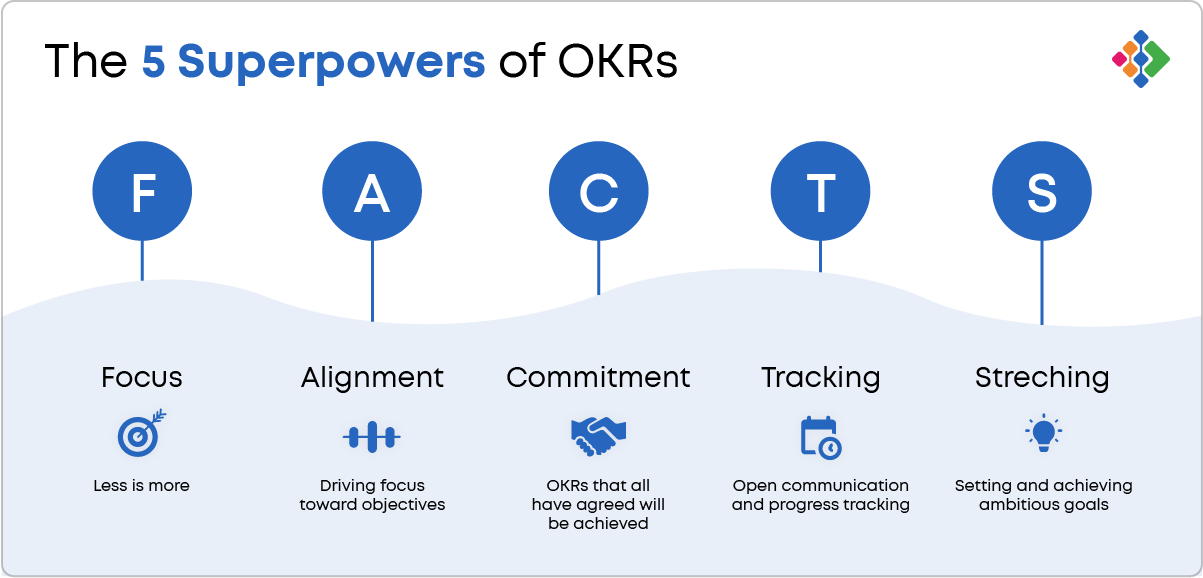
Proper alignment is the cornerstone of sustainable growth. It ensures that short-term efforts are in sync with long-term vision and objectives. Recognizing the importance of aligning business objectives (company OKRs) with the actional plans at the team level (team OKRs) is not just a strategy, it's the ultimate approach to successful strategy execution.
I'll support this statement with numbers. According to PMI survey data, aligned projects have a 50% higher chance of being completed on time and within budget and 57% are more likely to contribute to the achievement of the strategic goals.
This translates to a substantial increase in the number of companies seeking to adopt this method for planning and measuring what matters the most. It encourages involving everyone in the process of setting OKRs, rather than concentrating on micromanagement and directing teams to specific tasks.
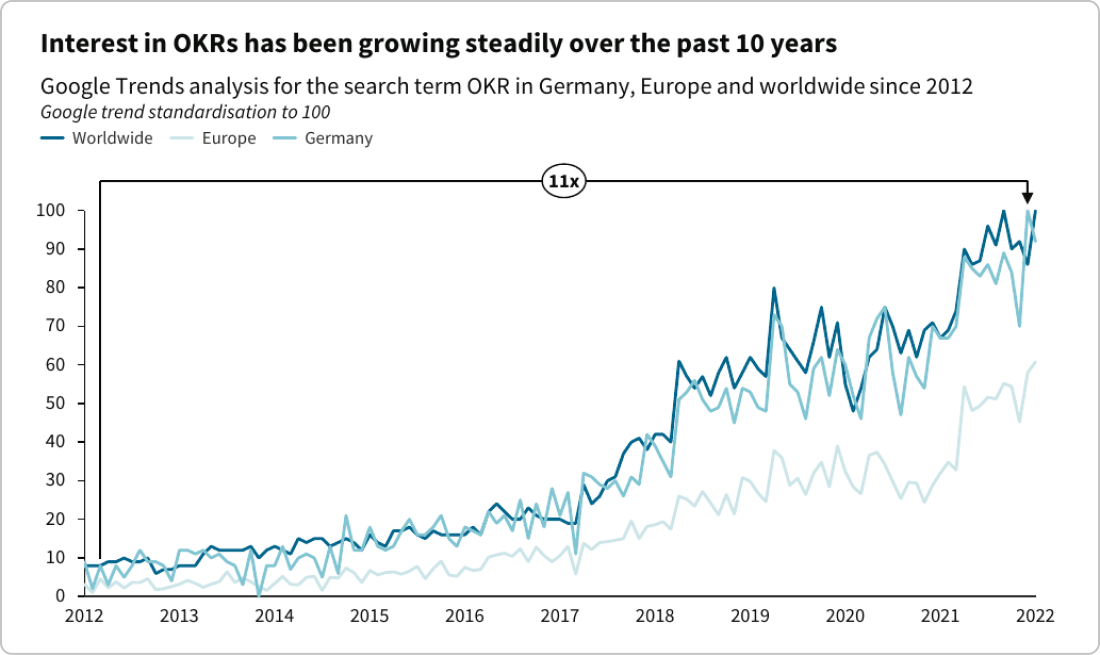 Source: (OKR Impact Report 2022)
Source: (OKR Impact Report 2022)
As a company that believes in the positive benefits of OKRs, here at Businessmap (formerly Kanbanize), we are inspired by the potential of OKRs to drive success. Each team aligns their team-level OKRs with the overall company OKRs. To maintain flexibility, we avoid rigidly cascading top-down OKRs, where the company's Key Results become the objectives for various departments or teams. Instead, we prioritize decentralizing control, allowing teams to create their own OKRs that support the broader goals.
When we say we do not cascade down OKRs in our organization, it doesn’t mean we deny this approach for creating and managing OKRs. As aligning OKRs is more of an Agile-based approach, we are in favor of this style of structuring OKRs. One good reason is that we want our OKRs to be developed as much top-down as they are bottom-up.
Our dedicated article "Cascading OKRs or Aligning Goals: What Path to Take" provides more on this topic.
Different Approaches to Align Organizational Goals
Naturally, we want our OKRs to be in full alignment, so everyone understands how their work contributes to the bigger picture. How this works - OKRs should flow both top-down and bottom-up in the organization. Executive leadership sets high-level company OKRs that cascade down to each department and team. At the same time, teams should be empowered to set their own OKRs that align with and support the company's goals. This creates a two-way dialogue and shared ownership.
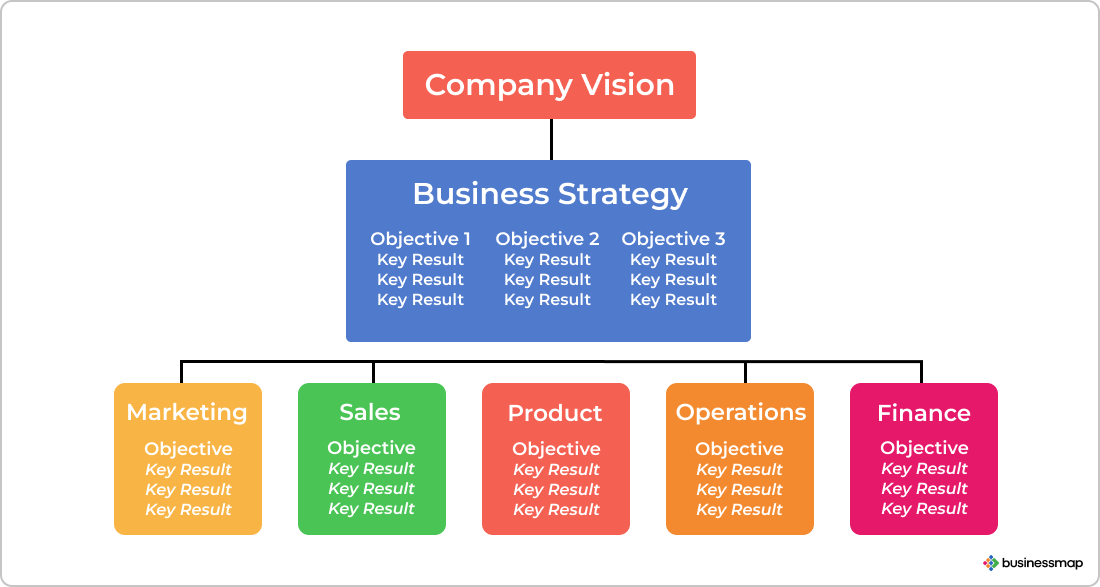 Aligning top-level and team-level OKRs to the company vision
Aligning top-level and team-level OKRs to the company vision
Teams often find themselves in a situation where they do not know where to begin when it comes to crafting their OKRs. When aligning team OKRs with leadership goals, there are 2 (or maybe 3) styles. Let’s break them down.
Explicit Alignment: Inheriting a Key Result and Make It an Objective
In explicit alignment, OKRs at lower levels (teams or individuals) are directly derived from higher-level OKRs. This often means that the key results of a higher-level OKR become the objectives for lower-level OKRs. Then, it is the team’s task to craft their set of key results.
Example:
Company-level OKR
Objective: Expand market reach in Latin America
- Key Result 1: Expand strategic partnerships by 15 more within the next 6 months.
- Key Result 2: Increase the organic traffic coming from this region by 20% within the next 6 months.
- Key Result 3: Enter three new international markets within the next 6 months.
Strategic Partnerships team OKR
Objective: Expand strategic partnerships within the next 6 months.
- Key Result 1: Establish 10 new partners by the end of Q3.
- Key Result 2: Gain 15 leads per event that our team attends.
- Key Result 3: Increase closed deals by 15%.
Directional Alignment: Get Inspired by Higher-Level OKRs
In directional alignment, higher-level OKRs provide a broad direction or strategic intent, but lower-level teams and individuals have the autonomy to set their own OKRs that align with this direction.
Example:
Company-level OKR
Objective: Expand market reach in Latin America
- Key Result 1: Expand strategic partnership by 15 more within the next 6 months.
- Key Result 2: Increase brand awareness in new international markets.
-
Key Result 3: Enter three new international markets within the next 6 months.
Marketing team OKR:
Objective: Make our brand twice as recognizable in the next 6 months.
- Key Result 1: Increase the organic traffic coming from this region by 20% within the next 6 months.
- Key Result 2: Sponsor at least 3 events in our target industries.
- Key Result 3: Grow social media following in new markets by 50%.
Shared OKRs Alignment: One OKR, Multiple Teams
A shared OKR is an objective, which might be inherited or inspired by a top goal and set of key results that are collaboratively owned and pursued by multiple teams, departments, or individuals within an organization. This approach fosters cross-functional collaboration and ensures that various parts of the organization work together towards a common goal.
Example:
Shared OKR:
Objective: Improve overall customer experience across all touchpoints.
Key Result 1: Increase customer satisfaction score to 95% by the end of Q4.
Key Result 2: Reduce customer support response time to under 2 hours.
Key Result 3: Achieve a Net Promoter Score (NPS) of 50.
In this example, the shared OKR aligns the efforts of the customer support, support, and marketing teams towards the common goal of improving the overall customer experience.
The Classical Structure of Aligning Company and Team OKRs
Let’s face it – without a proper digital platform, it would be nearly impossible to put into practice the whole theory behind aligning OKRs, for the most part at least.
In the following paragraphs, we will show you how to display and align your OKRs using a proper project portfolio management solution. For the sake of the example, we will use Businessmap.
Let’s begin, shall we?
To start this off, it is essential to have an OKR dashboard or a visual management board like a kanban board to visualize and monitor the progress of your whole work from top to bottom.
With Businessmap, you can achieve full transparency and build a complete hierarchical structure of the company and team OKRs within a single board. The master Management (or portfolio) board allows leaders to craft their high-level objectives and connect them to the OKRs of the respective teams.
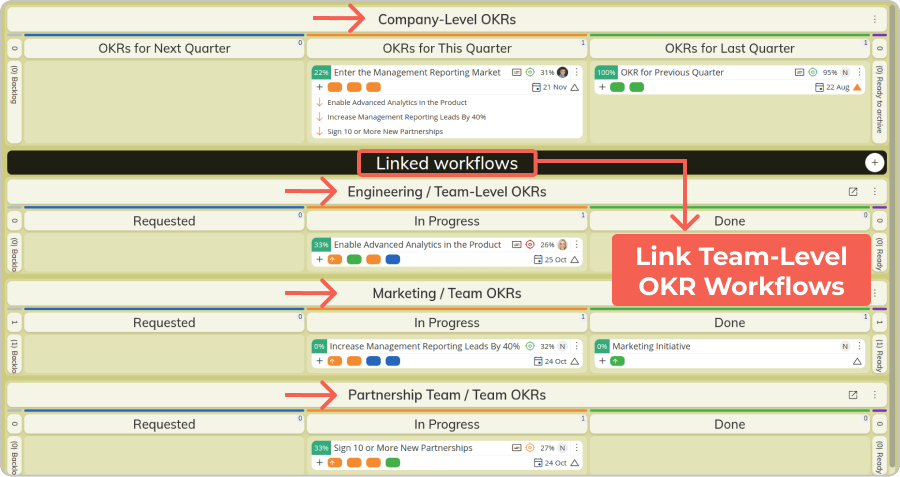 Gaining transparency over the company and team OKRs with Linked Workflows
Gaining transparency over the company and team OKRs with Linked Workflows
Using the “Measurable Outcomes” feature (as shown on the image below) inside initiatives provides a straightforward way for an objective and its constituting key results to be created.
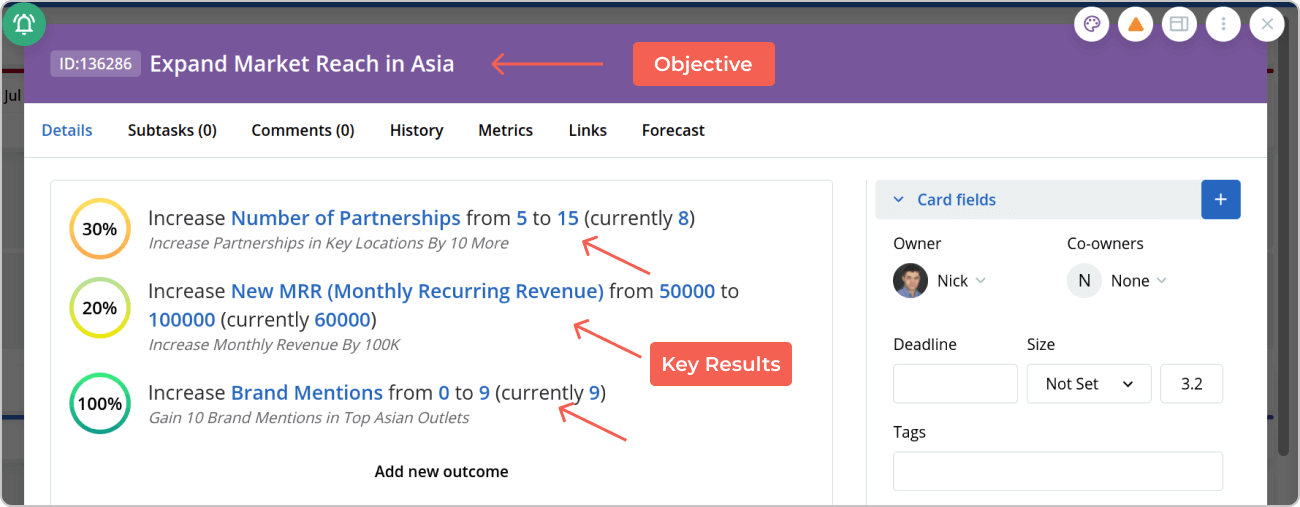 Visualizing company OKRs using Outcomes feature in Businessmap
Visualizing company OKRs using Outcomes feature in Businessmap
Once this is done, depending on the aligning approach, every team has the autonomy to come up with their own OKRs and visualize them on their separate management board.
Team kanban boards play a pivotal role in tracking and optimizing daily work activities. By linking team OKRs to actual work activities, these boards provide a comprehensive overview of how work progress directly contributes to the achievement of team goals.
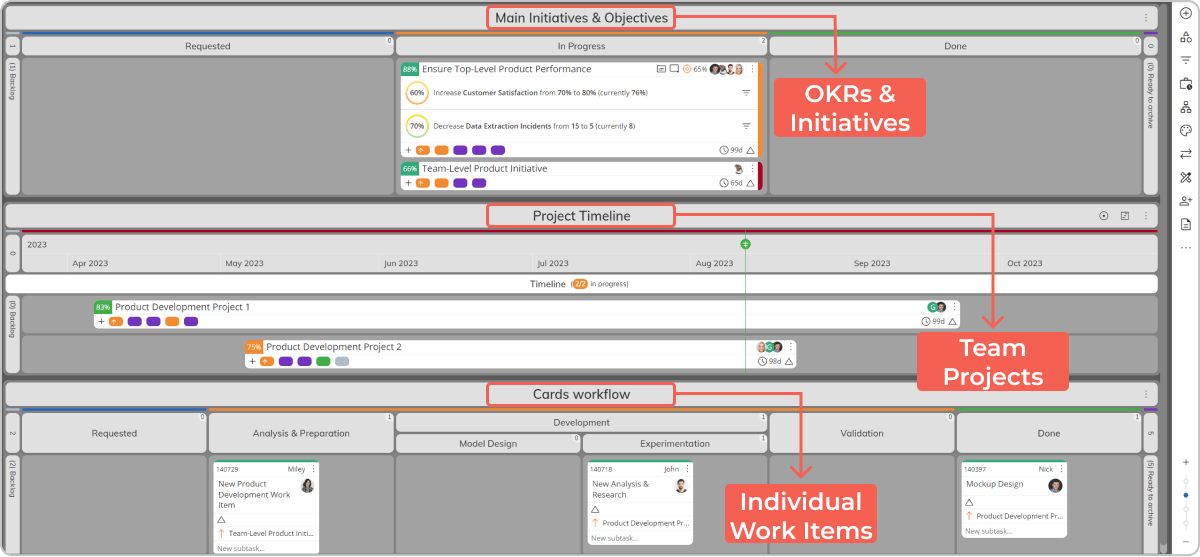
After all is said and done so far, this is how the alignment of objectives on both company and team levels looks in a digital platform.
At the top, we have the high-level objectives that serve the purpose of a north start for the entire company. Going down, we have each team's objectives derived from the top goals of the company. In between, there is this linked parent-child relation that keeps the whole structure connected and aligned.
Because of this linked system, everyone stays informed about every status update and progress tracking of OKR. This level of transparency allows leaders not to lose a sign of what is going on and to see the big picture from above and across.
Keep These Practices Always on Your Mind
Alignment isn't just about setting goals. It's about fostering an environment of transparency and communication. To achieve a successful OKR implementation, we share a few good practices that work for us personally. We hope you take them with you after finishing this article.
- Have regular check-ins. OKR is not a destination but a journey, meaning you can't just write them down and leave them there. Holding regular OKR cycles on different levels allows you to discuss progress, address roadblocks, and make necessary adjustments to maintain alignment.
- Open communication. When everyone feels free to speak their minds, it encourages active participation and contribution to developing the current and future OKRs.
- Be agile. Nothing kills progress like resistance to change and an inability to stay resilient. Business priorities shift all the time, so be flexible enough to adapt to them.
- Invest in OKR software. Choose a suitable digital platform to keep everything in one place and instantly measure OKR success.
At the end ...
... aligning OKRs helps create a cohesive and focused organization where every team and individual contributes to the broader strategic objectives, leading to improved performance, better collaboration, and more effective execution of the company’s vision.
If you strive to achieve all of that, Businessmap is here to help you structure and align your OKRs.
Businessmap is the most flexible software, helping your company gain visibility across all projects/portfolios, align on goals, and deliver quality work faster.

Michaela Toneva
Kanban & Agile Practitioner | SEO & Content Creator
With a never-ending thirst for knowledge and a passion for continuous improvement, Michaela is an Agile practitioner with a good understanding of Kanban, Lean, and Agile methodologies. Her professional background includes SEO and content writing with a dose of sales and a pinch of social media.



